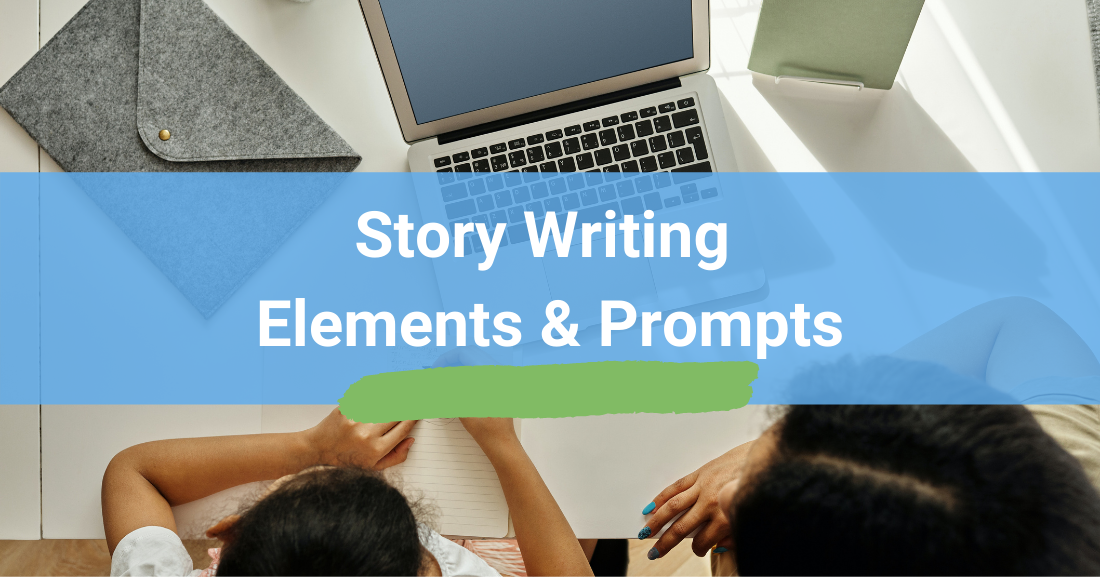When it comes to teaching your students the elements of story writing, it’s easy to start piling too much on.
There are so many minute facets to the craft. From arcs, themes, subplots, dimensions, conflict to dialogue, world-building, and… But this blog post isn’t aimed at teaching high-school level story building.
It’s aimed to give you resources and practical tips and exercise for teaching the building blocks of storytelling.
Though this guide can be adapted for more advanced students, and we do have additional advanced-level resources and tips scattered throughout, we recommend a “layering” approach when teaching concepts like arcs, themes, and foreshadowing.
But - above all - we recommend starting with the bones of the project and layer pieces on one by one. And, of course, every good story needs a good idea first!

Story Writing Prompts
Story prompts are a great way to give students a basepoint for the plot, conflict, and natural story arc. You can go over disecting these various parts during, before, or after their stories are written.
It’s especially useful to ask older students to identify the incitting incident, climax, themes, and resolution within eachother’s stories. It’s not just helpful for the students identifying, either, the writer can use this feedback to refine their themes, arcs, characters - or anything else!
For Beginners
If you have younger students who are just learning to write stories, we think this story writing worksheet would be the best fit. It gives students the basic outline of what a story is; who does what, where, when, and why. And - most importantly - how do they resolve the what? At the end, there’s an easy-to-follow checklist to let students know when their story is polished enough to be done.
As a bonus, it gives students several descriptions and ideas, and the entire worksheet is customizable.
For Intermediate
This PowerPoint slideshow is aimed at intermediate students who are writing short stories. It goes through the basic plot points of who, when, where, what, why, and how, with a little more emphasis on chronological order and adjectives.
After that, there are a few options. You can create groups and use this worksheet as a building block for a group story. Or you can ask students to pick a character, setting, time, object, and situation from this writing prompts sheet - which is also fully customizable.
It comes with a selection of ideas that could be mashed up like, “An octopus with a false set of teeth was turning into another creature in the sewer before he started a new job.” Or “In outer space, a child who is always grumbling and has a golden amulet, must stop the bomb sent to destroy the Earth in the night.”
Experienced
The same writing prompts worksheet from above works for experienced writers as well. Although it would likely work as is, if you think your students need a bigger push, it’s fully customizable.
If you really want to push your students to the brink of their creative abilities, you can always cut out each square and have students pick their character, setting, time, object, and situation at random by drawing their papers from several bags.
Of course, your students can put those things together any way that they see fit. So even if two students got the same exact prompt, their stories could be “Everyday, the stampeeding elephant rescued the one armed teacher from the burning building with a submarine,” or “Everyday in the burning building, the one armed teacher with a submarine and the stampeding elephant…”
In either case, turning those mismatched bits into a cohesive story is certainly no easy task, but it definitely makes writing more fun!
If that’s not going to fit your class, you can inspire the next generation’s Stephen King or Agathe Cristie with these crime or horror story prompts. Of course, you can use those worksheets as inspiration to your own worksheets as both of those are fully customizable as well.
ESL
For teaching story writing to ESL students, you may find it easier if you start with a partial story and have your students fill in the blanks. This story writing prompt gives you just that. You can let your students creativity out, but give them an easier format to do it in.
Plot
If your students need something more open-ended to work on constructing their own plots, characters, and scenes, this story outline worksheet might be your next stop. It’s similar to the story outline worksheet for beginner writer’s prompts, but it’s far more open-ended than the one listed above and doesn’t have quite as much hand-holding involved.
But, if they need a bit of crash-course on the topic and you need some guidance on how to, well, guide them, we have a blog post about teaching plot construction that might help you.

Teaching Character Development
This character and personality worksheet is generally better for slightly older students who can understand the difference between who someone thinks they are and who the world thinks they are. But it’s a good foundation for talking about perceptions and how that might cause conflict within the story (IE: man vs society and/or self.)
The next worksheet is meant to be used as an exercise in description, but we thought it fit here as a template for character descriptions. Although it could very well be used as intended for the purpose of hands-on character descriptions. If you want one that doesn’t potentially single out students, here’s a more standard character sketch template.
We also have a list of appearance and character adjectives that might help your students get ideas for their characters.
Setting
For students who need a little nudge in scenery and setting descriptions, this setting worksheet is a good starting point for setting the mood of a setting. Though you could, of course, use it as inspiration for any settings worksheet with any picture or list of descriptive words.
If you’re interested in a lesson that’s off-paper, we have some fun ideas for expanding vocabulary - particularly for scenery and sensory details - in another blog post about creative writing.
Teaching Students Story Conflict
Man versus fellow man, man versus self, man versus nature, man versus society… you get it. But do your students?
Plots are useless without obstacles and conflict - and usually a substancial doses. Teaching your students how to structure conflict, spot potential additional conflict, and deepen their story with internal and external conflict is best done when you can examine examples of how it’s done.
This conflict in literature worksheet is a good starting point for examinging conflict tropes in literature, but it’s also useful for talking about how life - in general - is full of conflict so your students can draw inspiration from almost everyone and everything around them.
Themes In Literature
Themes are generally reserved for more advanced students, which is why it ended up last on our list. But it’s best to tackle themes prior to character, conflict, or even basic plot development.
The best examples of themeatic literature include Romeo & Juliet and Pride & Prejudice. Both of these worksheets work best with the movie versus the book, since the language in the book is probably a bit heavy for most students.
However, both movies retain a large portion of their themes; death, fate, man v. society, and opression in Romeo & Juleit, and pride in class systems and reputation as well as prejudice towards gender, class, and families in Pride and Prejudice.
Additionally, poetry has a good deal of themes and moods to explore. That worksheet includes two poems with questions about themes, moods, and contextual clues for how to deduce what the theme and moods are.
Teaching Students To Write Detail
Many - dare we say most? - students are notorious under-writers. Whether it’s fear of ridicule or lack of inspiration that’s to blame, we can’t say.
But if your students seem to be struggling, we have some practical tips for getting your students to expand their writing by elaborating on descriptions, feelings, similies, and sensory details - to name a few.
Need More Help?
If you’re teaching some more experienced students the craft and want to dive into things like character flaws, world-building, genre placements, point of view, or any other more advanced story writing element, we encourage you to check out our blog post about what to do with writing prompts.
P.S. If you enjoyed this article, please help spread it by clicking one of those sharing buttons below. And if you are interested in more, you should follow our Facebook page where we share more about creative, non-boring ways to teach English.







